Responses of Vegetation Cover to Environmental Change in Large Cities of China
Abstract
:1. Introduction
2. Materials and Methods
2.1. Data
2.2. Methods
2.2.1. City Selection and Quantification of Urban Land Expansion
2.2.2. Analysis of Spatiotemporal Variations
2.2.3. Analyzing the Sensitivity of G-NDVI to Climate Change
2.2.4. Quantifying the Impact of Urbanization on G-NDVI Change
3. Results
3.1. Spatiotemporal Variation Analyses
3.1.1. Climate Factors
3.1.2. Urban Lands
3.1.3. G-NDVI
3.2. Sensitivity of G-NDVI to Climate Change
3.2.1. Relationship between Mean Annual G-NDVI and Climate
3.2.2. Relationship between G-NDVI Variations and Climate Change
3.3. Impact of Urbanization on G-NDVI Change
4. Discussion
4.1. Diversities in the Spatial Distribution of Mean Annual G-NDVI
4.2. Driving Forces of the Temporal Variability of G-NDVI
5. Conclusions
- (1)
- The mean annual G-T, G-P and G-NDVI of the selected 71 cities are found to be greatly different. The spatial difference of G-NDVI is closely related to diverse climate conditions. Overall, the mean annual G-NDVI of 71 cities increases from dry-cool climate to humid-hot climate.
- (2)
- The changes of G-T, G-P, PU and G-NDVI during 1998–2012 are different among the selected 71 cities. The mean values of ΔPUZ1 and ΔPUZ2 were 37% and 22% respectively, indicating that the selected 71 cities have experienced rapid urbanization during 1998–2012. The trend rates of G-NDVIZ1 and G-NDVIZ2 range from −0.099 to 0.067 per decade and −0.082 to 0.092 per decade respectively. G-NDVI changes are less sensitive to climate change, while closely related to urban land expansion. There is a negative correlation between G-NDVI trend and PU change, indicating vegetation cover in cities has been negatively impacted by urbanization.
- (3)
- For most of the inland cities, vegetation cover in urban areas has experienced more severe urbanization impact than in suburban areas. But opposites occur in the 17 cities mainly located in the coastal areas of China. The average impacts of urbanization on G-NDVI change were estimated to be −0.026 per decade in Z1 and −0.015 per decade in Z2 during 1998–2012.
Supplementary Materials
Acknowledgments
Author Contributions
Conflicts of Interest
References
- Grimm, N.B.; Faeth, S.H.; Golubiewski, N.E.; Redman, C.L.; Wu, J.; Bai, X.; Briggs, J.M. Global Change and the Ecology of Cities. Science 2008, 319, 756–760. [Google Scholar] [CrossRef] [PubMed]
- Wu, J. Urban sustainability: An inevitable goal of landscape research. Landsc. Ecol. 2010, 25, 1–4. [Google Scholar] [CrossRef]
- Bolund, P.; Hunhammar, S. Ecosystem services in urban areas. Ecol. Econ. 1999, 29, 293–301. [Google Scholar] [CrossRef]
- Robinson, S.L.; Lundholm, J.T. Ecosystem services provided by urban spontaneous vegetation. Urban Ecosyst. 2012, 15, 545–557. [Google Scholar] [CrossRef]
- Gratani, L.; Varone, L.; Bonito, A. Carbon sequestration of four urban parks in Rome. Urban For. Urban Green. 2016, 19, 184–193. [Google Scholar] [CrossRef]
- Jonsson, P. Vegetation as an urban climate control in the subtropical city of Gaborone. Botsw. Int. J. Climatol. 2004, 24, 1307–1322. [Google Scholar] [CrossRef]
- Escobedo, F.J.; Nowak, D.J. Spatial heterogeneity and air pollution removal by an urban forest. Landsc. Urban Plan. 2009, 90, 102–110. [Google Scholar] [CrossRef]
- Dana, E.D.; Vivas, S.; Mota, J.F. Urban vegetation of Almerı́a City—A contribution to urban ecology in Spain. Landsc. Urban Plan. 2002, 59, 203–216. [Google Scholar] [CrossRef]
- Jenerette, G.D.; Harlan, S.L.; Stefanov, W.L.; Martin, C.A. Ecosystem services and urban heat riskscape moderation: Water, green spaces, and social inequality in Phoenix, USA. Ecol. Appl. 2011, 21, 2637–2651. [Google Scholar] [CrossRef] [PubMed]
- Marignani, M.; Chiarucci, A.; Sadori, L.; Mercuri, A.M. Natural and human impact in Mediterranean landscapes: An intriguing puzzle or only a question of time? Plant Biosyst. 2016, 151, 900–905. [Google Scholar] [CrossRef]
- Mercuri, A.M.; Marignani, M.; Sadori, L. Palaeoecology and long-term human impact in plant biology. G. Bot. Ital. 2015, 149, 136–143. [Google Scholar] [CrossRef]
- Li, Y.; Wu, J.; Hou, S.; Shi, C.; Mo, D.; Liu, B.; Zhou, L. Palaeoecological records of environmental change and cultural development from the Liangzhu and Qujialing archaeological sites in the middle and lower reaches of the Yangtze River. Quat. Int. 2010, 227, 29–37. [Google Scholar] [CrossRef]
- Wang, J.; Meng, J.J.; Cai, Y.L. Assessing vegetation dynamics impacted by climate change in the southwestern karst region of China with AVHRR NDVI and AVHRR NPP time-series. Environ. Geol. 2008, 54, 1185–1195. [Google Scholar] [CrossRef]
- Ruimy, A.; Saugier, B.; Dedieu, G. Methodology for the estimation of terrestrial net primary production from remotely sensed data. J. Geophys. Res. Atmos. 1994, 99, 5263–5283. [Google Scholar] [CrossRef]
- Fu, Y.; Lu, X.; Zhao, Y.; Zeng, X.; Xia, L. Assessment Impacts of Weather and Land Use/Land Cover (LULC) Change on Urban Vegetation Net Primary Productivity (NPP): A Case Study in Guangzhou, China. Remote Sens. 2013, 5, 4125–4144. [Google Scholar] [CrossRef]
- Zeng, X.; Dickinson, R.E.; Walker, A.; Shaikh, M. Derivation and Evaluation of Global 1-km Fractional Vegetation Cover Data for Land Modeling. J. Appl. Meteorol. 1999, 39, 826–839. [Google Scholar] [CrossRef]
- Suzuki, R.; Nomaki, T.; Yasunari, T. Spatial distribution and its seasonality of satellite-derived vegetation index (NDVI) and climate in Siberia. Int. J. Climatol. 2001, 21, 1321–1335. [Google Scholar] [CrossRef]
- Peng, J.; Shen, H.; Wu, W.; Liu, Y.; Wang, Y. Net primary productivity (NPP) dynamics and associated urbanization driving forces in metropolitan areas: A case study in Beijing City, China. Landsc. Ecol. 2016, 31, 1077–1092. [Google Scholar] [CrossRef]
- Eastman, J.R.; Sangermano, F.; Machado, E.A.; Rogan, J.; Anyamba, A. Global Trends in Seasonality of Normalized Difference Vegetation Index (NDVI), 1982–2011. Remote Sens. 2013, 5, 4799–4818. [Google Scholar] [CrossRef]
- Li, H.; Li, Y.; Gao, Y.; Zou, C.; Yan, S.; Gao, J. Human Impact on Vegetation Dynamics around Lhasa, Southern Tibetan Plateau, China. Sustainability 2016, 8, 1146. [Google Scholar] [CrossRef]
- Wen, Z.F.; Wu, S.J.; Chen, J.L.; Lv, M.Q. NDVI indicated long-term interannual changes in vegetation activities and their responses to climatic and anthropogenic factors in the Three Gorges Reservoir Region, China. Sci. Total Environ. 2017, 574, 947–959. [Google Scholar] [CrossRef] [PubMed]
- Blok, D.; Schaepman-Strub, G.; Bartholomeus, H.; Heijmans, M.M.P.D.; Maximov, T.C.; Berendse, F. The response of Arctic vegetation to the summer climate: Relation between shrub cover, NDVI, surface albedo and temperature. Environ. Res. Lett. 2011, 6, 035502. [Google Scholar] [CrossRef]
- Gessner, U.; Naeimi, V.; Klein, I.; Kuenzer, C.; Klein, D.; Dech, S. The relationship between precipitation anomalies and satellite-derived vegetation activity in Central Asia. Glob. Planet. Chang. 2013, 110, 74–87. [Google Scholar] [CrossRef]
- Bai, J.J.; Bai, J.T.; Wang, L. Spatio-temporal change of vegetation NDVI and its relations with regional climate in Northern Shaanxi Province since implementation of returning farmland to forests project. In Proceedings of the 2013 Second International Conference on Agro-Geoinformatics (Agro-Geoinformatics), Fairfax, VA, USA, 12–16 August 2013. [Google Scholar] [CrossRef]
- Fuller, D.O.; Prince, S.D. Rainfall and foliar dynamics in tropical southern Africa: Potential impacts of global climate change on savanna vegetation. Clim. Chang. 1996, 33, 69–96. [Google Scholar] [CrossRef]
- Piao, S.; Mohammat, A.; Fang, J.; Cai, Q.; Feng, J. NDVI-based increase in growth of temperate grasslands and its responses to climate changes in China. Glob. Environ. Chang. 2006, 16, 340–348. [Google Scholar] [CrossRef]
- Zhou, L.; Tucker, C.J.; Kaufmann, R.K.; Slayback, D.; Shabanov, N.V.; Myneni, R.B. Variations in northern vegetation activity inferred from satellite data of vegetation index during 1981 to 1999. J. Geophys. Res. Atmos. 2001, 106, 20069–20084. [Google Scholar] [CrossRef]
- Sun, Y.; Zhao, S.; Qu, W. Quantifying spatiotemporal patterns of urban expansion in three capital cities in Northeast China over the past three decades using satellite data sets. Environ. Earth Sci. 2015, 73, 7221–7235. [Google Scholar] [CrossRef]
- Wu, J.; Xiang, W.N.; Zhao, J. Urban ecology in china: Historical developments and future directions. Landsc. Urban Plan. 2014, 125, 222–233. [Google Scholar] [CrossRef]
- Imhoff, M.L.; Lawrence, W.T.; Elvidge, C.D.; Paul, T.; Levine, E.; Privalsky, M.V.; Brown, V. Using nighttime DMSP/OLS images of city lights to estimate the impact of urban land use on soil resources in the United States. Remote Sens. Environ. 1997, 59, 105–117. [Google Scholar] [CrossRef]
- Lin, T.; Grimm, N.B. Comparative study of urban ecology development in the U.S. and China: Opportunity and Challenge. Urban Ecosyst. 2015, 18, 599–611. [Google Scholar] [CrossRef]
- Li, F.; Wang, R.; Paulussen, J.; Liu, X. Comprehensive concept planning of urban greening based on ecological principles: A case study in Beijing, China. Landsc. Urban Plan. 2005, 72, 325–336. [Google Scholar] [CrossRef]
- Jim, C.Y.; Chen, S.S. Comprehensive greenspace planning based on landscape ecology principles in compact Nanjing city, China. Landsc. Urban Plan. 2003, 65, 95–116. [Google Scholar] [CrossRef]
- Sun, J.; Wang, X.; Chen, A.; Ma, Y.; Cui, M.; Piao, S. NDVI indicated characteristics of vegetation cover change in China's metropolises over the last three decades. Environ. Monit. Assess. 2011, 179, 1–14. [Google Scholar] [CrossRef] [PubMed]
- Memon, R.A.; Leung, D.Y.; Chunho, L. A review on the generation, determination and mitigation of urban heat island. J. Environ. Sci. 2008, 20, 120–128. [Google Scholar]
- Lu, P.; Qiang, Y.; Liu, J.; Lee, X. Advance of tree-flowering dates in response to urban climate change. Agric. For. Meteorol. 2006, 138, 120–131. [Google Scholar] [CrossRef]
- Buyantuyev, A.; Wu, J. Urbanization diversifies land surface phenology in arid environments: Interactions among vegetation, climatic variation, and land use pattern in the Phoenix metropolitan region, USA. Landsc. Urban Plan. 2012, 105, 149–159. [Google Scholar] [CrossRef]
- Buyantuyev, A.; Wu, J. Urbanization alters spatiotemporal patterns of ecosystem primary production: A case study of the Phoenix metropolitan region, USA. J. Arid Environ. 2009, 73, 512–520. [Google Scholar] [CrossRef]
- Jin, K.; Wang, F.; Chen, D.; Jiao, Q.; Xia, L.; Fleskens, L. Assessment of urban effect on observed warming trends during 1955–2012 over China: A case of 45 cities. Clim. Chang. 2015, 132, 631–643. [Google Scholar] [CrossRef]
- Wang, J.; Wang, K.; Zhang, M.; Zhang, C. Impacts of climate change and human activities on vegetation cover in hilly southern China. Ecol. Eng. 2015, 81, 451–461. [Google Scholar] [CrossRef]
- Cao, L.; Zhu, Y.; Tang, G.; Yuan, F.; Yan, Z. Climatic warming in China according to a homogenized data set from 2419 stations. Int. J. Climatol. 2016, 36, 4384–4392. [Google Scholar] [CrossRef]
- Cai, D.; Fraedrich, K.; Guan, Y.; Guo, S.; Zhang, C. Urbanization and the thermal environment of Chinese and US-American cities. Sci. Total Environ. 2017, 589, 200–211. [Google Scholar] [CrossRef] [PubMed]
- Li, Y.J.; Zeng, H.; Wei, J.B. Vegetation change in Shenzhen City based on NDVI change classification. Chin. J. Appl. Ecol. 2008, 19, 1064–1070. (In Chinese) [Google Scholar]
- Xia, B.; Yu, X.X.; Ning, J.K.; Wang, X.P.; Qin, Y.S.; Chen, J.Q. Landscape pattern evolution of Beijing in recent 20 years. J. Beijing For. Univ. 2008, 30, 60–66. (In Chinese) [Google Scholar]
- Liu, Z.; He, C.; Zhang, Q.; Huang, Q.; Yang, Y. Extracting the dynamics of urban expansion in China using DMSP-OLS nighttime light data from 1992 to 2008. Landsc. Urban Plan. 2012, 106, 62–72. [Google Scholar] [CrossRef]
- Han, G.F.; Xu, J.H. Vegetation change trajectory and the reasons in Shanghai City. Acta Ecol. Sin. 2009, 29, 1793–1803. (In Chinese) [Google Scholar]
- Tian, G.; Jiang, J.; Yang, Z.; Zhang, Y. The urban growth, size distribution and spatio-temporal dynamic pattern of the Yangtze River Delta megalopolitan region, China. Ecol. Model. 2011, 222, 865–878. [Google Scholar] [CrossRef]
- Liu, C.L.; Yu, R.L. Spatial Accessibility of Road Network in Wuhan Metropolitan Area Based on Spatial Syntax. Acta Geogr. Sin. 2012, 4, 128–135. [Google Scholar] [CrossRef]
- Angert, A.L.; Huxman, T.E.; Barron-Gafford, G.A.; Gerst, K.L.; Venablem, D.L. Linking growth strategies to long-term population dynamics in a guild of desert annuals. J. Ecol. 2007, 95, 321–331. [Google Scholar] [CrossRef]
- Julien, Y.; Sobrino, J. Global land surface phenology trends from GIMMS database. Int. J. Remote Sens. 2009, 30, 3495–3513. [Google Scholar] [CrossRef]
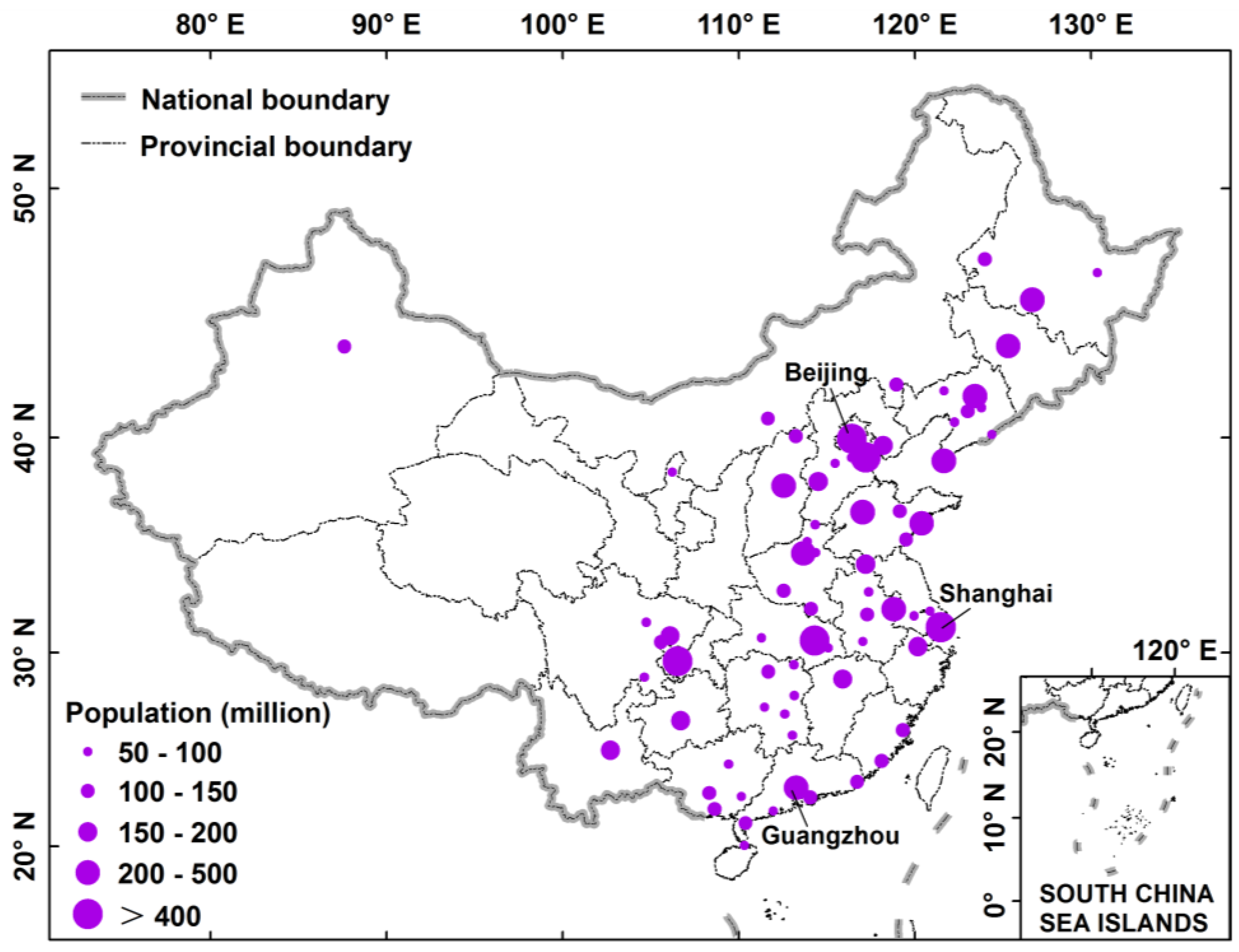


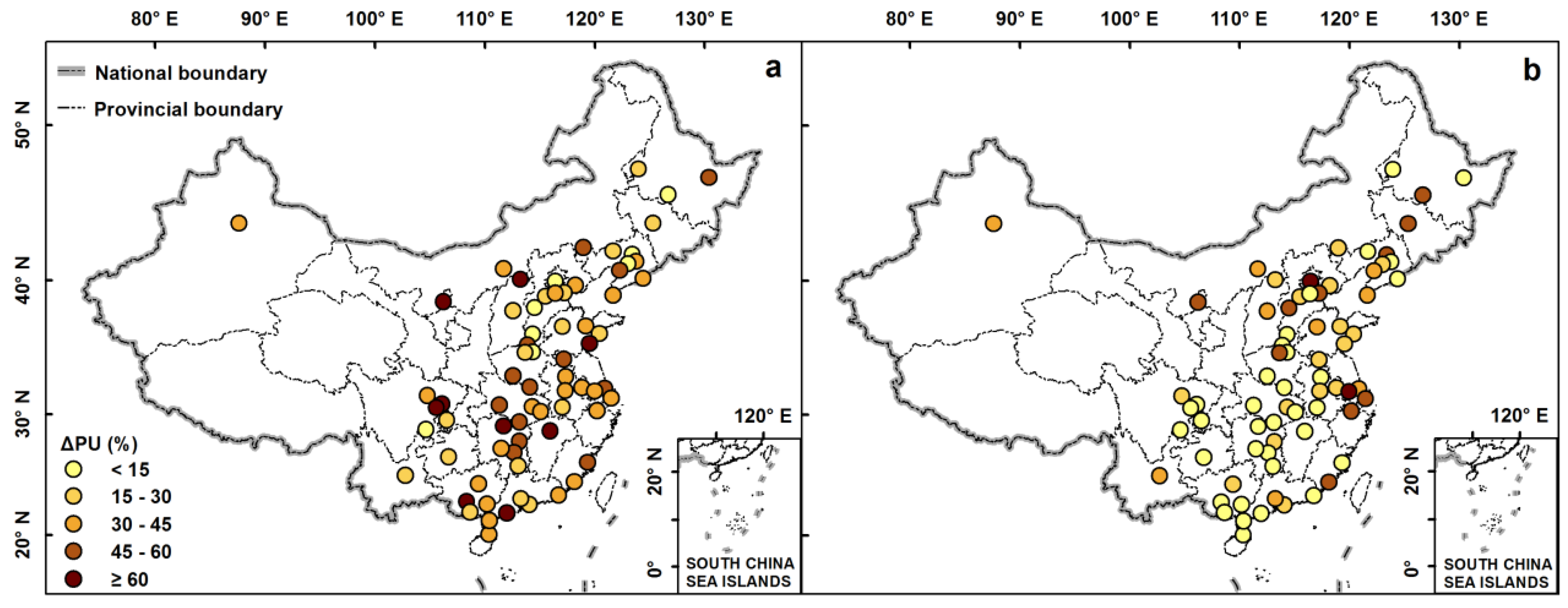
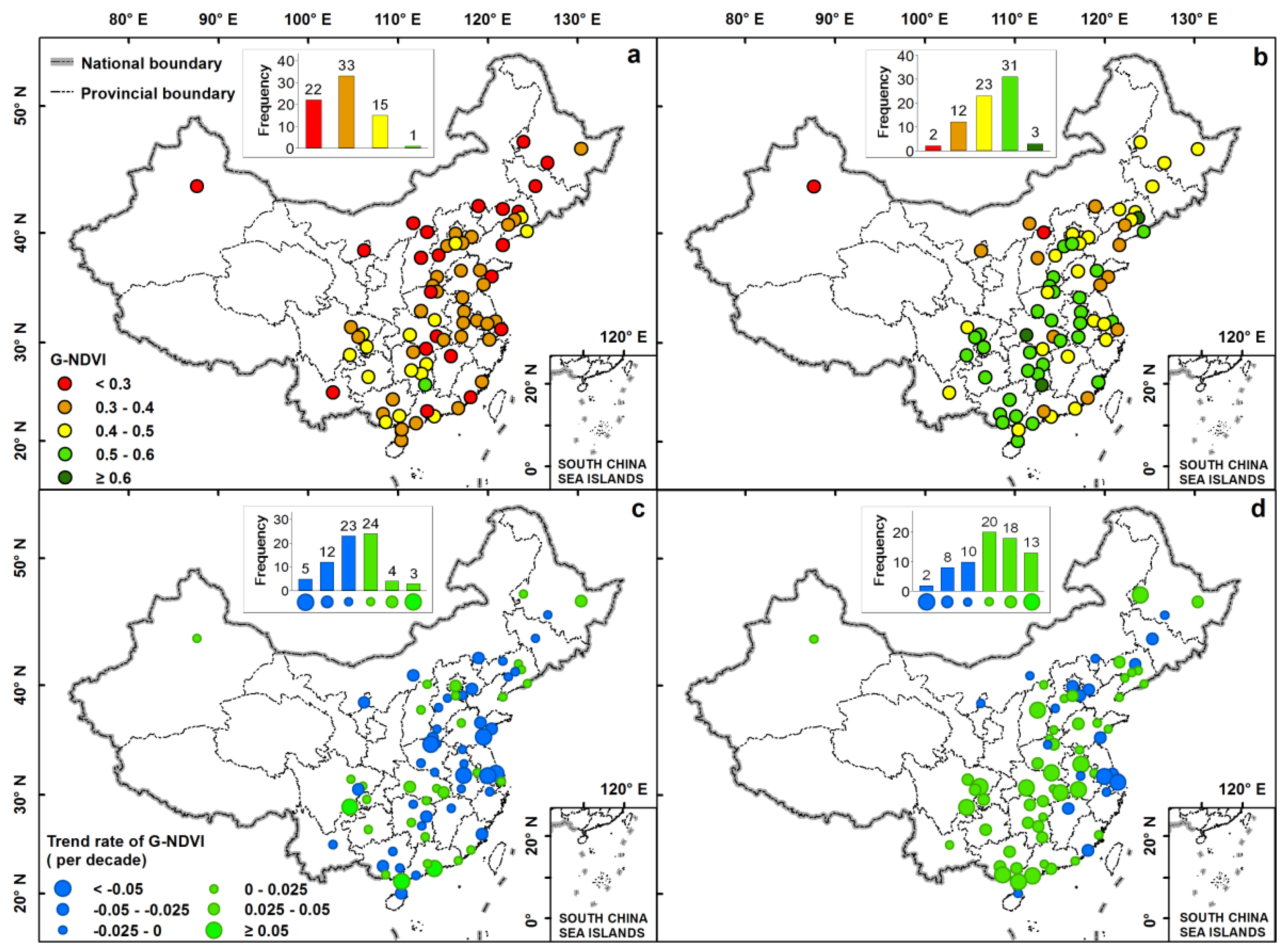
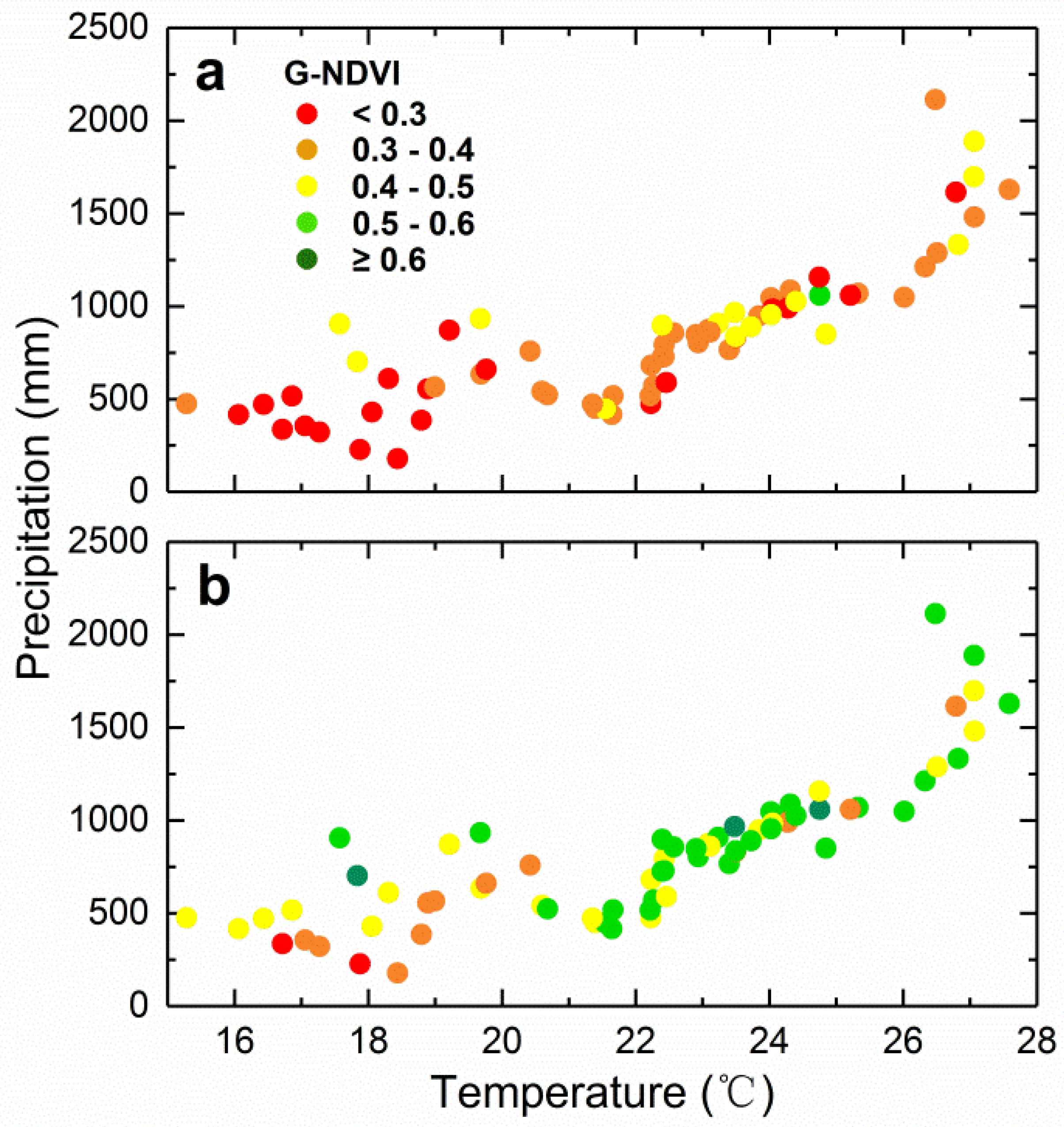
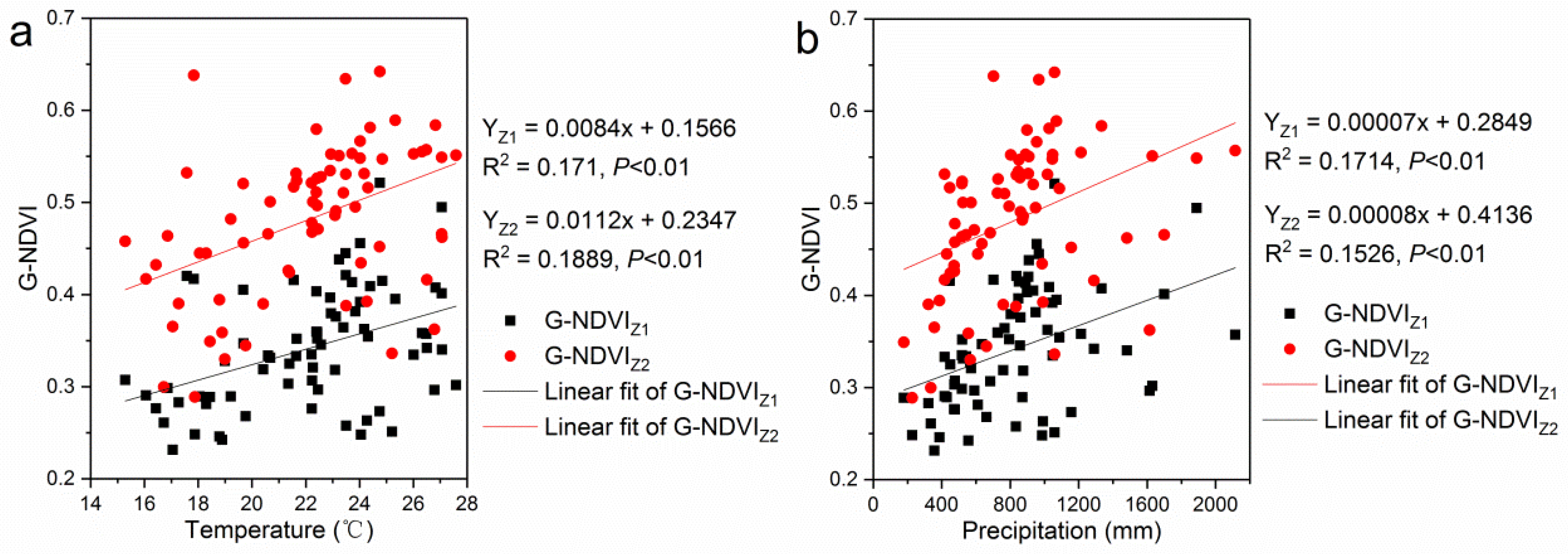

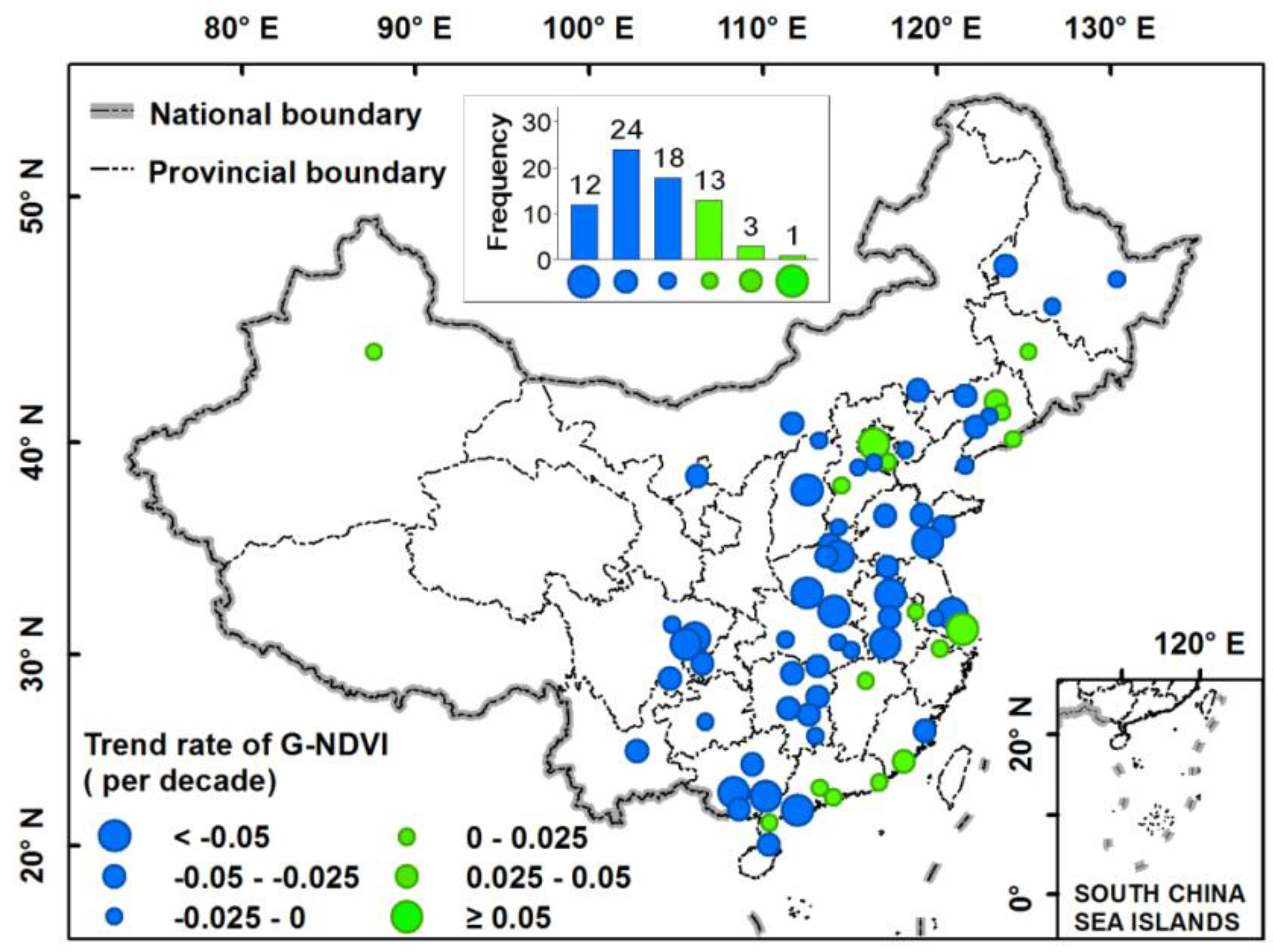

| Mean Annual Value | Change Trend | ΔPUZ1 5 | ΔPUZ2 6 | |||||||
|---|---|---|---|---|---|---|---|---|---|---|
| G-NDVIZ1 1 | G-NDVIZ2 2 | G-T 3 | G-P 4 | G-NDVIZ1 | G-NDVIZ2 | G-T | G-P | |||
| Mean | 0.34 | 0.48 | 22.1 | 827 | −0.007 | 0.016 | −0.10 | −37 | 37 | 22 |
| Standard deviation | 0.06 | 0.08 | 3.2 | 385 | 0.031 | 0.034 | 0.44 | 159 | 18 | 19 |
| Range of value | 0.29 | 0.35 | 12.3 | 1936 | 0.166 | 0.174 | 1.86 | 863 | 76 | 78 |
| Minimum | 0.23 | 0.29 | 15.3 | 178 | −0.099 | −0.082 | −1.12 | −396 | 1 | 0 |
| Maximum | 0.52 | 0.64 | 27.6 | 2114 | 0.067 | 0.092 | 0.74 | 467 | 77 | 78 |
| ΔPUZ1 1 | ΔPUZ2 2 | Trend Rate of G-T 3 | Trend Rate of G-P 4 | |
|---|---|---|---|---|
| Trend rate of G-NDVIZ1 5 | −0.37 ** | −0.21 | −0.17 | −0.20 |
| Trend rate of G-NDVIZ2 6 | 0.04 | −0.70 ** | −0.10 | −0.19 |
© 2018 by the authors. Licensee MDPI, Basel, Switzerland. This article is an open access article distributed under the terms and conditions of the Creative Commons Attribution (CC BY) license (http://creativecommons.org/licenses/by/4.0/).
Share and Cite
Jin, K.; Wang, F.; Li, P. Responses of Vegetation Cover to Environmental Change in Large Cities of China. Sustainability 2018, 10, 270. https://doi.org/10.3390/su10010270
Jin K, Wang F, Li P. Responses of Vegetation Cover to Environmental Change in Large Cities of China. Sustainability. 2018; 10(1):270. https://doi.org/10.3390/su10010270
Chicago/Turabian StyleJin, Kai, Fei Wang, and Pengfei Li. 2018. "Responses of Vegetation Cover to Environmental Change in Large Cities of China" Sustainability 10, no. 1: 270. https://doi.org/10.3390/su10010270
APA StyleJin, K., Wang, F., & Li, P. (2018). Responses of Vegetation Cover to Environmental Change in Large Cities of China. Sustainability, 10(1), 270. https://doi.org/10.3390/su10010270






